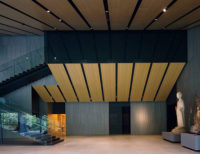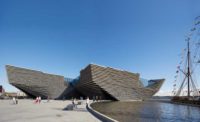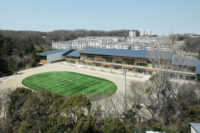Within the library of Japan’s Kadokawa Culture Museum, designed by Kengo Kuma & Associates (KKAA), staggered planks of cedar plywood form bookshelves that rise to a towering 26 feet. The museum is part of Tokorozawa Sakura Town, a pop-cultural complex northwest of Tokyo that includes a book-manufacturing facility, event halls, retail, and an anime-themed hotel. The museum, described by Kuma’s team as a “futuristic labyrinth of modern society,” aims to prompt the pursuit of knowledge while breaking barriers to access often associated with museums and libraries (even if many of the books are literally out of reach). The shelves’ complexity is meant to reflect “the agitation of culture,” according to KKAA partner Suguru Watanabe, and to refer to the chigai-dana (staggered shelves) and kasumi-dana (shelving arranged to represent mist or clouds) found in the Japanese Shoin-zukuri style, which forms the basis of traditional residential architecture. “We aimed to create shelving that looks like a brain structure that connects forever,” Watanabe says. Twenty-five units, supported by steel-and-wood brackets and interspersed with 24 video monitors, comprise the soaring walls of the 900-square-foot, double-height library. The gargantuan bookshelves display some 30,000 volumes, which—upon request—the staff pluck at night, using an aerial work platform, to have ready for readers the next day.
Kadokawa Culture Museum Library by Kengo Kuma & Associates
Tokyo

Kadokawa Culture Museum Library. Photo © Ryosuke Kosuge





Post a comment to this article
Report Abusive Comment